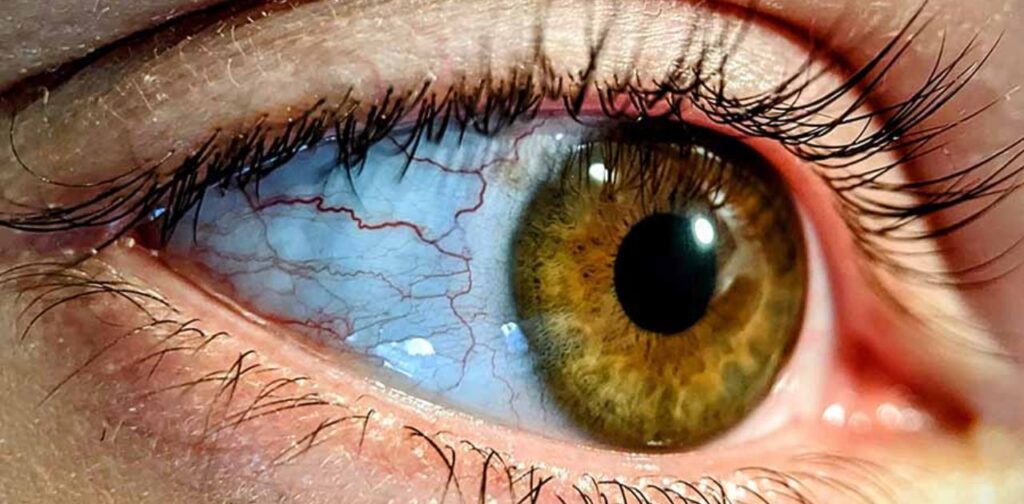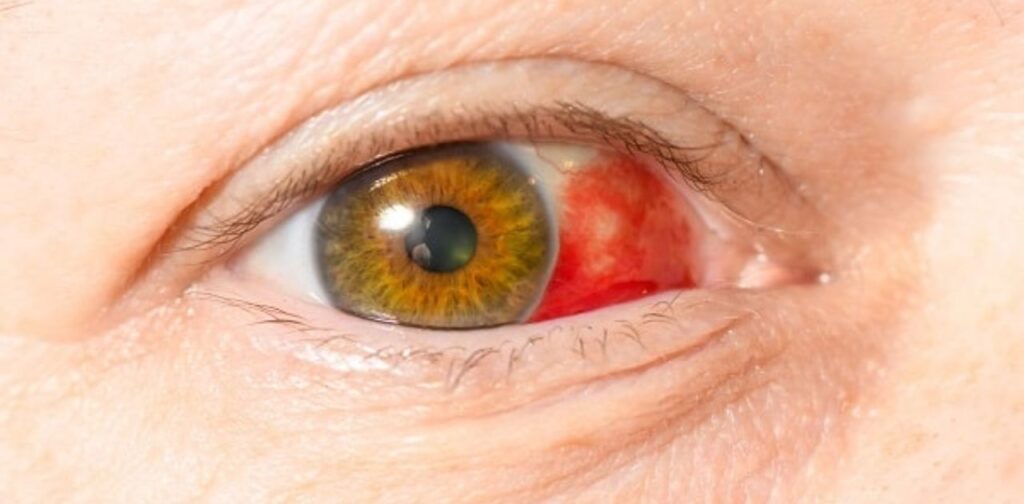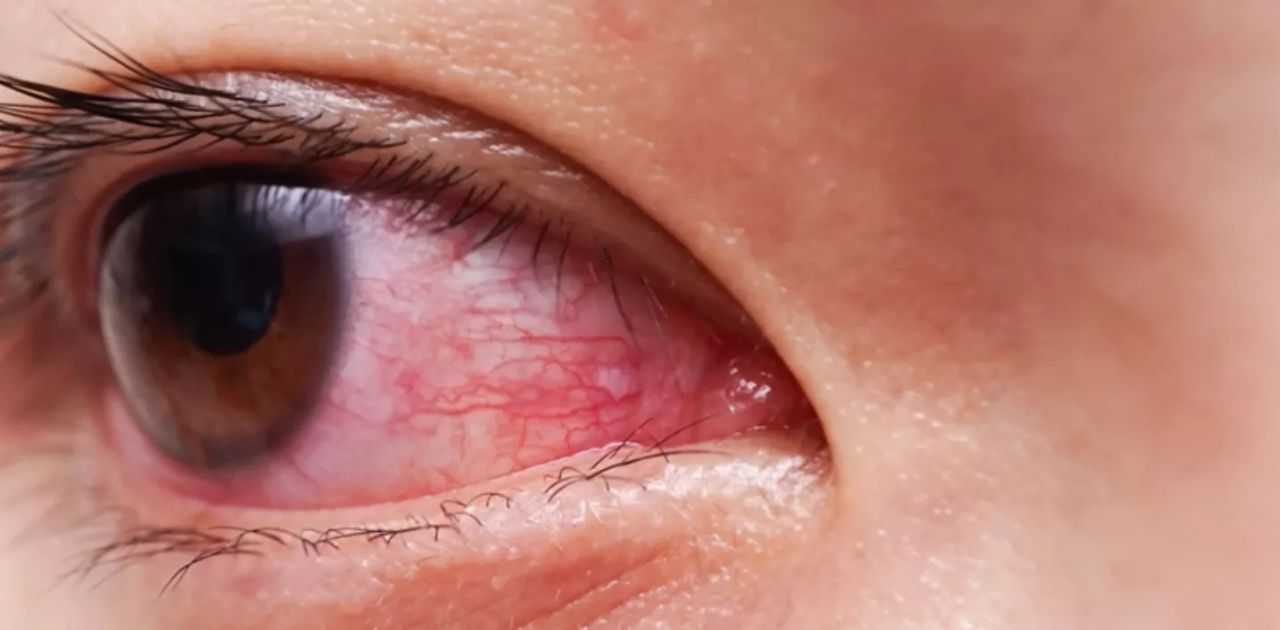Ever glanced in the mirror and found your eyes looking like a roadmap of tiny red lines? You’re not alone. Bloodshot eyes are a common occurrence that can range from a minor annoyance to a sign of something more serious.
In this comprehensive guide, we’ll dive into the world of red eyes, exploring causes, treatments, and when it’s time to seek medical attention.
What’s Behind Those Red Eyes? Understanding the Causes
Everyday Culprits: Irritants and Environmental Factors
Your eyes are sensitive organs, and they’re constantly exposed to the world around you. It’s no wonder they sometimes get a little irritated! Environmental factors play a significant role in causing bloodshot eyes. Here’s what you need to know:
- Dust and smoke: These tiny particles are like sandpaper for your eyes. They can irritate the conjunctiva (the clear membrane covering the white of your eye), causing blood vessels to dilate and become more visible.
- Allergens: Pollen, pet dander, and mold spores can trigger an allergic response in your eyes, leading to redness, itching, and watering.
- Wind and dry air: These conditions can cause your tears to evaporate too quickly, leaving your eyes dry and irritated.
“The eyes are more exact witnesses than the ears.” – Heraclitus
Burning the Candle at Both Ends: Eye Strain and Fatigue
In our digital age, eye strain has become increasingly common. Here’s how your lifestyle might be contributing to those bloodshot peepers:
- Digital eye strain: Prolonged use of digital devices like computers, smartphones, and tablets can lead to Computer Vision Syndrome (CVS). Symptoms include red, dry eyes, blurred vision, and headaches.
- Lack of sleep: When you don’t get enough shut-eye, your eyes don’t get the rest and lubrication they need. This can lead to dryness and redness.
Table: Common Symptoms of Digital Eye Strain
| Symptom | Description |
| Eye redness | Blood vessels in the eyes become dilated and more visible |
| Dry eyes | Reduced blinking leads to inadequate tear production |
| Blurred vision | Difficulty focusing on screen content |
| Headaches | Often occur after prolonged screen use |
| Neck and shoulder pain | Poor posture while using devices |
Dry Eyes: When Your Peepers Need a Drink
Dry eye syndrome is a common condition that occurs when your eyes don’t produce enough tears or when your tears evaporate too quickly. This can lead to redness, irritation, and a gritty feeling in your eyes. Factors contributing to dry eyes include:
- Age (it’s more common as we get older)
- Certain medications
- Medical conditions like rheumatoid arthritis or Sjögren’s syndrome
- Environmental factors like low humidity or windy conditions
When Bloodshot Eyes Signal Something More Serious
While often harmless, bloodshot eyes can sometimes indicate underlying medical conditions that require attention. Let’s explore some of these conditions:
Conjunctivitis: Not Just a Fancy Word for Pink Eye
Conjunctivitis, commonly known as pink eye, is an inflammation of the conjunctiva. It can be caused by viruses, bacteria, or allergens. Here’s what you need to know:
- Viral conjunctivitis: Often associated with colds or flu, it’s highly contagious and typically clears up on its own in 1-2 weeks.
- Bacterial conjunctivitis: This type requires antibiotic treatment and can cause significant discomfort and discharge.
- Allergic conjunctivitis: Triggered by allergens, it’s often seasonal and can be managed with antihistamine eye drops.
Blepharitis: When Your Eyelids Join the Red Party
Blepharitis is an inflammation of the eyelids that can cause redness, swelling, and crusting around the eyelashes. Symptoms include:
- Redness of the eyes and eyelids
- Itching or burning sensation
- Flaking skin on the eyelids
- Crusty eyelashes upon waking
Uveitis: The Hidden Threat
Uveitis is a less common but potentially serious condition involving inflammation of the uvea, the middle layer of the eye. It can cause:
- Redness and pain in the eye
- Sensitivity to light
- Blurred vision
- Floaters in your field of vision
“The eyes are the window of the soul.” – William Shakespeare
Red Flags: When Should You Be Concerned About Bloodshot Eyes?

While most cases of bloodshot eyes are harmless, there are times when they warrant immediate medical attention. Here are some red flags to watch out for:
Vision Changes: More Than Meets the Eye
If you experience sudden vision changes along with bloodshot eyes, it’s time to see a doctor. Watch out for:
- Sudden blurriness or vision loss
- Double vision
- Halos around lights
These symptoms could indicate serious conditions like retinal detachment or acute glaucoma.
Eye Pain: When Your Peepers Scream for Help
Eye pain accompanied by redness is another reason to seek medical attention. It could be a sign of:
- Glaucoma: A sudden increase in eye pressure can cause severe pain and redness.
- Corneal ulcers: Open sores on the cornea can be caused by infections or injuries.
- Uveitis: As mentioned earlier, this inflammation can cause significant pain and redness.
Something’s Leaking: Discharge or Excessive Tearing
Unusual discharge or excessive tearing along with bloodshot eyes could indicate:
- Bacterial infections: Often produce thick, yellow discharge
- Viral infections: Usually cause more watery discharge
- Blocked tear ducts: Can lead to excessive tearing and irritation
DIY Relief: Home Remedies for Mild Bloodshot Eyes
For mild cases of bloodshot eyes, try these home remedies before reaching for medication:
Hot and Cold: The Magic of Compresses
- Warm compresses: Great for relieving eye strain and improving circulation. Apply for 5-10 minutes.
- Cold compresses: Ideal for reducing swelling and soothing irritation. Use for short periods of 1-2 minutes at a time.
Over-the-Counter Eye Drops: Choosing Your Weapon
Over-the-counter eye drops can provide quick relief for many causes of bloodshot eyes:
- Artificial tears: Lubricate dry eyes and wash away irritants
- Antihistamine drops: Reduce itching and redness caused by allergies
Hydrate and Hibernate: Simple Yet Effective Solutions
- Stay hydrated: Drinking enough water helps maintain proper eye lubrication
- Get enough sleep: Aim for 7-9 hours per night to give your eyes time to rest and recover
When Home Remedies Aren’t Enough: Medical Treatments
If home remedies don’t provide relief, it’s time to consider medical treatment options:
Prescription Eye Drops: The Big Guns
Your doctor may prescribe:
- Steroid drops: To reduce inflammation in conditions like uveitis
- Antibiotic drops: For bacterial infections like bacterial conjunctivitis
Punctal Plugs: Damming the Waterworks
For chronic dry eyes, your doctor might recommend punctal plugs:
- Temporary plugs: Made of collagen, they dissolve over time
- Permanent plugs: Made of silicone for long-term use
The Last Resort: Surgical Interventions
In rare cases, surgery may be necessary to address the underlying cause of bloodshot eyes, such as:
- Glaucoma surgery: To relieve intraocular pressure
- Corneal transplant: For severe corneal damage
Little Red Eyes: Bloodshot Eyes in Children

Children can also experience bloodshot eyes. Here’s what parents should know:
Why Johnny’s Eyes Look Like a Roadmap
Common causes in children include:
- Conjunctivitis: Highly contagious in school settings
- Foreign objects: Kids are prone to getting small particles in their eyes
- Allergies: Seasonal allergies can affect children’s eyes too
When to Rush to the Pediatrician
Seek immediate medical attention if your child experiences:
- Eye pain or discomfort
- Vision changes
- Excessive tearing or discharge
- Sensitivity to light
An Ounce of Prevention: Keeping Bloodshot Eyes at Bay
Prevention is always better than cure. Here are some tips to keep your eyes clear and healthy:
Eye Hygiene: More Than Just a Fancy Phrase
- Wash your hands frequently: Especially before touching your face or eyes
- Avoid rubbing your eyes: This can introduce bacteria and irritants
Shield Those Peepers: Proper Eye Protection
- Wear sunglasses: Choose ones that block 99-100% of UV rays
- Use safety goggles: When working with tools or in dusty environments
By following these tips and being aware of the signs and symptoms of more serious conditions, you can keep your eyes healthy and clear. Remember, if you’re ever in doubt about the cause of your bloodshot eyes or if symptoms persist, it’s always best to consult with an eye care professional.
Conclusion
When it comes to bloodshot eyes, knowledge is power. From everyday irritants to more serious medical conditions, we’ve covered the spectrum of causes and solutions. Remember, while many cases of red eyes can be handled with simple home remedies, it’s crucial to listen to what your eyes are telling you.
If you’re dealing with persistent redness, pain, or vision changes, don’t hesitate to seek professional help. After all, your eyes are your windows to the world – they deserve the best care possible.
Whether you’re battling digital eye strain, allergies, or just a case of tired eyes, there are steps you can take to keep your peepers looking and feeling their best. Stay hydrated, practice good eye hygiene, protect your eyes from harsh environments, and give them the rest they need.
By being proactive about your eye health, you can reduce the frequency of those bothersome bloodshot episodes and keep your eyes sparkling clear.



